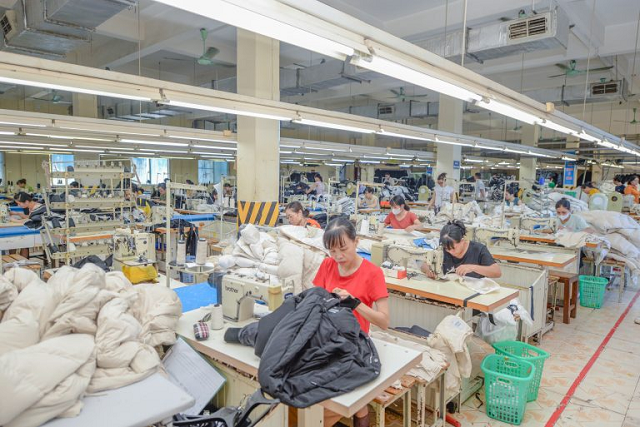On July 4, with the unanimous approval of delegates present, the Hanoi City People’s Council passed a resolution on the questioning session at the 17th meeting of the 16th term, Hanoi City People’s Council, for the 2021-2026 term.
Regarding the group of issues related to vocational training and job creation in the city, the People’s Council requested that the People’s Committee direct the relevant departments, sectors, and units to advise and propose implementations that clearly define responsibilities. They should also develop mechanisms, policies, solutions, and roadmaps to effectively address and resolve limitations and remove obstacles mentioned in the report.
Review the planning of the network of vocational education institutions in the city for the 2021-2030 period, with a vision towards 2045, to be included in the Master Plan for the Capital until 2030, with a vision towards 2050 (implemented according to Decision No. 73/QD-TTg dated February 10, 2023, of the Prime Minister approving the planning of the network of vocational education institutions for the period 2021 – 2030, with a vision towards 2045).
Continue to review and build policies to support vocational training and job creation, encouraging businesses to participate in renewing and improving the quality of vocational education to meet the requirements of the labor market. Proactively review and prepare the conditions to build mechanisms and policies in accordance with the amended Capital Law, which was passed by the National Assembly at the 7th session…
EXCEEDING TARGETS IN VOCATIONAL TRAINING AND JOB CREATION
Earlier, in the afternoon of July 3, at the questioning and answering session within the framework of the 17th session of the Hanoi City People’s Council, Vice Chairman of the City People’s Committee Vu Thu Ha affirmed that the propaganda of policies on vocational training and job creation for workers in the city has been strongly promoted through various media and social networks.

The results of vocational enrollment for the period of 2020 – 2023 exceeded the planned target by 6.14%. The proportion of trained workers has increased continuously year after year, making an important contribution to providing trained workers for the labor market in the capital and surrounding areas.
The percentage of trained workers has increased steadily over the years, rising from 70.25% in 2020 to 73.23% in 2023 (an increase of 2.98%). Among them, the percentage of workers with qualifications increased from 48.5% in 2020 to 52.5% in 2023 (an increase of 4.0%). Compared to the national percentage, as of 2023, the percentage of trained workers in Hanoi is 5.23 percentage points higher, and the percentage of workers with qualifications is 25 percentage points higher than the national average.
The quality of vocational education in the capital has been increasingly affirmed and improved, and the “Labor Training Index” of the city in the PCI index has been highly evaluated by enterprises: In the period of 2020 – 2023, Hanoi ranked first twice (in 2021 and 2023).
Regarding job creation, in the period of 2020-2022 and the first 6 months of 2024: The city created jobs for 902,431 people (an increase of 23% compared to the period of 2016 – 2019). This includes providing jobs for 229,489 people through the approval of loans from the city’s budget capital entrusted to the Hanoi branch of the Social Policy Bank, with a total value of VND 8,950 billion; sending 15,600 laborers to work abroad under contracts; and providing vocational training for 2,794 unemployed insured laborers, with a total cost of VND 7.1 billion.
By 2023, the number of employed workers in Hanoi accounted for about 31% of the country’s total. The unemployment rate among the working-age population in the city was 2.01% (0.27 percentage points lower than the national average). Specifically, the unemployment rate in urban areas decreased to 2.97%, and the unemployment rate in rural areas was 1.01%.
CONTINUING TO IMPROVE THE QUALITY OF VOCATIONAL EDUCATION INSTITUTIONS
Along with the achievements, there are also certain limitations and difficulties. One of them is the mindset that still values academic degrees over vocational skills among some citizens. Most students who graduate from high school aim to enter university and are not interested in pursuing vocational training.
Furthermore, as the capital city, Hanoi is home to many universities with large enrollment quotas and low admission criteria. As a result, intermediate and college-level schools face significant challenges in competing for students with universities.

There is a lack of coordination between enterprises providing employment services and the Hanoi Center for Employment Services, as well as satellite transaction floors and points, to better serve job seekers and businesses with recruitment needs, especially in supporting job placement for people with disabilities…
The identification and forecasting of recruitment needs of enterprises, as well as the assessment of labor supply and forecasting of job demands of job seekers in the labor market, are still limited in terms of both quantity and quality. The products for labor market forecasting are insufficient and sometimes untimely.
Regarding solutions to promote the deployment of vocational training and job creation in the city in the coming time, Vice Chairman of the City People’s Committee Vu Thu Ha said that for vocational training, it is necessary to continue reviewing and improving the quality of vocational education institutions in the plans, programs, and projects on human resource development of the city, as well as in the planning of the network of vocational education institutions for the period of 2021-2030, with a vision towards 2045, after it is issued.
Along with this, it is crucial to strengthen the propagation and dissemination of the Party’s guidelines and the State’s policies, as well as the directives of the city on human resource development and job creation. Diversifying propaganda methods, developing news articles and columns in the press, and propagating through the information system of districts, counties, and towns are also essential.
Additionally, strengthening the connection between vocational education institutions and employment service centers, job transaction floors, job fairs, and innovation and startup centers is vital. Supporting students in finding jobs after graduation and linking training with sending laborers to work abroad under contracts should also be prioritized.
Moreover, continuing to coordinate closely with departments, branches, districts, counties, and towns to proactively advise the People’s Council and the People’s Committee of the city on the issuance of timely policies to support vocational training for workers in the area, in line with the socio-economic development and characteristics of the capital…
CONTINUING TO INVEST IN PROGRAMS, CURRICULA, ESPECIALLY IN AI-RELATED FIELDS
At the meeting, in response to questions related to the impact of artificial intelligence (AI) technology on vocational training and the inclusion of new occupations such as live streamers, TikTokers, and YouTubers in the curriculum, Ms. Bach Lien Huong, Director of the Hanoi Department of Labor, Invalids, and Social Affairs, shared that the city will continue to improve the quality of vocational education institutions, especially public schools, in the coming time.
Along with this, the city will continue to invest in programs, curricula, and teaching materials, especially in new fields and those related to AI and current trends in vocational development.
In 2022, the Department advised the City People’s Committee to issue a list of 78 occupations with a training duration of less than 3 months. To ensure the practicality of this list, in 2023, the Department continued to coordinate with districts, counties, and towns to review and advise the City People’s Committee to adjust it.
As a result of the review, 77 occupations remained, with 15 new occupations added or adjusted. Notably, the list of 77 occupations includes new ones mentioned by the delegates, such as live streamer sales and household helpers. In terms of structure, out of the 77 occupations, 24 are in the agricultural sector and 53 are in the non-agricultural sector.
Concluding the questioning session, the Hanoi City People’s Council requested that the City People’s Committee, branches, levels, and sectors seriously and fully absorb the opinions of the delegates, as well as the recommendations and suggestions of voters and people. They should also promptly, synchronously, and effectively implement solutions and urgently direct the clear assignment of responsibilities, roadmap, and progress to overcome the existing shortcomings and remove obstacles. Additionally, they must seriously fulfill their commitments and promises to meet the expectations of voters and the people.
Hanoi’s Update on the Delayed 1.000 billion VND Hospital Project
To address the challenges faced by investors, the Hanoi People’s Committee has instructed the Long Bien People’s Committee and the Department of Natural Resources and Environment to resolve any obstacles that arise during the implementation of the Thang Long 1,000-Year Oncology and Plastic Surgery Hospital project.










































